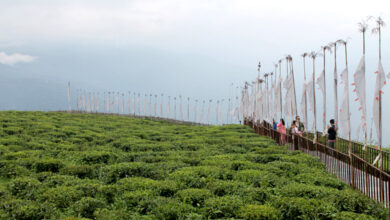What Are Essential Travel Hacks When Visiting Japan?

Unlock the secrets and techniques to essential travel hacks when visiting japan enjoy with our vital tour hacks. From navigating local customs to optimizing transportation, find out insider pointers for an unforgettable journey through the Land of the Rising Sun. Maximize your journey with realistic insights that make certain a clean and enriching trip to Japan.
Anybody who is asked what their dream destination is would almost certainly say “Japan.” The nation has experienced a surge in popularity due to its rich past, verdant surroundings, and intricate towns filled with skyscrapers, temples, and tourist attractions. American Express reports that since 2019, reservations have surged by 1,300% (via Bloomberg).
The fact that Japanese culture and customs are so different from those of other nations is one of the things that draws people to Japan. It is also a daunting vacation destination because of this, particularly for first-time travellers. If you begin your trip in a big city like Tokyo, Yokohama, or Osaka, you are thrown into a world of neon lights, busy streets, cacophonous sounds, and a million unique smells and sensory overload.
A trip to Japan is definitely not the type of holiday you can wing it—there is just too much to see, see, and eat. Arriving prepared is key since the last thing you want is to encounter a problem that can be easily solved, such as not having internet or having to spend half an hour finding your way to your next location.
Essential Travel Hacks When Visiting Japan 7-Eleven for fast lunches.
In Japan, it’s difficult to stroll for more than twenty seconds without coming across a convenience store. Known by another name, conbini, these shops are typically open around-the-clock and provide a wide selection of excellent, reasonably priced delicacies to keep you going without requiring the time or money to dine at a real restaurant.
You may get items like onigiri rice balls, chicken karaage, sandos, oden, and bento boxes for as little as 200 yen ($1.34). We also suggest getting some taiyaki to give you a fast sugar rush. Made of pancake or waffle batter and shaped like fish, they are typically filled with chocolate, custard, and red bean paste and are incredibly addicting as a snack.
Buy a pocket Wi-Fi router.
Surprisingly little public Wi-Fi exists in Japan, which might get you into trouble if you get lost during your metro ride. Thankfully, there is portable Wi-Fi available, and it’s invaluable. You may rent a portable gadget that will let you use the internet anywhere, including on the train, for as little as $5 per day.Most of them include numerous device connections capabilities, a range of data rates and gigabytes, and some even provide limitless data for the duration of your visit.
You can pick up the device (also known by the much cuter name of a Wi-Fi Egg) at a designated counter once you’ve cleared customs at airports including Chubu Centrair, Kansai International, Fukuoka, Haneda and Narita in Tokyo, and more if you rent in advance through a website like Ninja WiFi or Japan Wireless. When you’re finished, you may simply place it in the returns box when you get to the airport. Simple.
Purchase a JR Pass
Regretfully, the Japan Rail Pass no longer costs as much as it formerly did. In July 2023, its value increased by 70% as the yen’s worth continued to fall in relation to other currencies globally. But even so, if your schedule calls for a lot of rail travel, it’s nevertheless.
With the Japan Rail Pass, you may travel by train anywhere you choose, including the Narita Express and the notorious, extremely fast Shinkansen bullet trains (for an additional cost). We advise purchasing yours in advance on the JRailPass website, where it costs $340.65 for seven days, $544.45 for fourteen days, and $680.35 for twenty-one days. Once in Japan, it becomes more costly.
Get maps and rail timetables by downloading them.
Japan has excellent public transport. If you’re visiting the nation for the first, second, or third time, it may also be rather intimidating. Tokyo’s metro system may be particularly challenging to use, with nine distinct train lines and 180 stops to choose from. The bulk of its roads have no names at all, making them even more complex.
Take use of Citymapper
Citymapper is essential if you’re going to be in Tokyo. As it does for several other locations worldwide, the accolade-winning program evaluates public transit, traffic, and distance to determine all the possible routes to your destination and the approximate time it will take.
To go from one place to another, choose your preferred mode of transportation (walking, cycling, cabs, subway, or a combination of all of them) and follow Citymapper’s detailed instructions. We truly mean it when we say “step-by-step.”
Because of its advanced intelligence, the app will even advise you on which exits and entrances to use at each station in order to minimize tension during your trip.
Visit between the months of January and March.
While there isn’t a single “best” time to visit Japan, there is a most practical period. January through March often brings the lowest airfares of the year along with less people. You may see Japan in the snow and avoid typhoon season, even though it will most likely be freezing.
Just make sure to confirm the dates of the Lunar New Year (also known as Chinese New Year) if you decide to come during this period. Since this is often a public holiday in the area, Japan’s cities will be crowded with visitors.
The “January to March is cheaper” guideline will not apply to this time of year since it is so popular, with hotels and airlines raising their rates throughout the holiday. The start of cherry blossom season, which occurs around the end of March, is comparable.
Make bookings in advance.
Japan offers a plethora of enjoyment. The issue is that these are things that everyone else wants to enjoy as well. Most tourist destinations don’t sell tickets at the gate and sometimes sell out months in advance, so there’s not much room for spontaneity for the typical traveller to Japan.
It’s advisable to get your tickets as soon as possible if you intend to visit places like the Studio Ghibli Museum, Tokyo Disney Resort, Ghibli Park, Shibuya Sky observation deck, Teamlab Planets, and Warner Bros. Studio Tour Tokyo – The Making of Harry Potter. The Ghibli Museum is especially tough, with tickets for the next month going on sale at 10 a.m. on the 10th of the month previous.
Select taxis over Uber.
Uber is available in Japan, although it’s not as popular or widely used as it is in the US, Canada, or the UK. Travels in general are more costly than those made in local taxis, which is why both locals and visitors prefer using the latter service.
Of course, Uber’s popularity among visitors is one of its advantages. The entire procedure is conducted in English, and ordering a cab and paying with a card is simple. However, as there is no basic charge for the pick-up service, hailing a cab on the street is your least expensive alternative. If an automobile is occupied, it will state so in Japanese on the front. Also, it is colour-coded, thus only visitors can understand.
Get a Suica card
What a Suica card can’t do is more important than what it can do. You may keep adding additional money to this prepaid, contactless card to pay for public transportation including buses, trains, metro, and taxis. In addition to transportation, numerous stores, eateries, cafés, and even vending machines take Suica. Simply keep an eye out for the Suica emblem to find out whether they do; if not, it’s still worthwhile to inquire.
To get your 500 yen ($12) deposit back, you may buy your card before you travel to Japan and return it when you’re done. As of June 2023, the sale of new Suica cards is temporarily suspended due to a lack of production; however, if you have a temporary visa, you may still purchase a Welcome Suica card. This is good for 28 days, doesn’t require a deposit, and doesn’t need to be returned. These are exclusively available for purchase within Japan, at airports like Narita and Haneda. They come with a reference sheet that you must always have with you.
Make use of storage lockers
Storage lockers are rare in train stations worldwide for security concerns. Japan is not like the others. It would be difficult to locate a large station in Tokyo without coin lockers (which, despite their name, can also be used with a Suica card). In fact, most stations have storage available.
One of those things you never really know you’ll need until you really do is baggage storage. If you want to stash your possessions so you may wander freely and just have a few hours before travelling to your hotel or next location, these lockers come in handy. Additionally, they are quite affordable, usually costing between $1 and $5.
Keep away in national holidays
There are other holidays besides Lunar New Year that are worth missing if you wish to avoid the throng. Everywhere there are national holidays, there are large crowds, but in Japan especially, workers have minimal yearly vacation and want to take advantage of the break. Should you brave major tourist destinations like Senso-ji Temple, Tokyo Skytree, or Shibuya Crossing, you’ll probably be surrounded by other travellers.
Conclusion:
As our exploration of critical travel hacks for travelling Japan concludes, the keys to unlocking a wealthy and hassle-free enjoy lie in preparedness and cultural sensitivity. By mixing those tour hacks into your itinerary, you no longer simplest navigate Japan’s particular customs and transportation intricacies, however additionally open doors to authentic and remarkable encounters. Embrace the beauty of this diverse united states of america, from its bustling city facilities to serene traditional landscapes, armed with the insights that make your adventure now not only a visit, however a cultural immersion. Safe travels on your Japanese adventure!”



